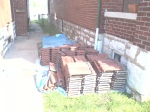Earlier this year I was asked to replace a leaking roof on a Patio of an Investment Property. The job consisted of Removing the existing Mound City Clay Roof Tiles from the Porch Roof and replacing with Certain Teed 3 Tab-Shingles (Energy Star Rated).
Rather than dispose of the Clay Roof Tiles in the local landfill I choose to "Recycle" the roof tiles and am happy to report that they went to a good home and will be re-installed on future roofs by: "Old World Roofing Company Slate and Tile Specialists"
- Mound City Clay Roof Tiles Recycled by Scotts Contracting
While I was at Old World Roofing Company and speaking with the business owner, Mr. Hagerty. We discussed the aspects of his business that has his business backlogged with future projects into 2012. I jumped at the opportunity to discuss and learn the various aspects that have made his business a success. And was thrilled to learn that the things that have made his business a success are the same principles that I incorporate into my small business:
"Honesty and hard work, prompt customer service, keeping the customer informed of the progress on the job, and providing quality work!"
We also discussed the aspects that make the Clay Roofing tiles a Green and Sustainable product. Clay Roofing Tiles-
- are traditionally made from locally available materials such as clay.
Clay as a building material is one of the oldest building materials on Earth, among other ancient, naturally occurring geologic materials such as stone and organic materials like wood. Between one-half and two-thirds of the world's population, in traditional societies as well as developed countries, still live or work in a building made with clay as an essential part of its load-bearing structure.re-posted from: http://en.wikipedia.org/wiki/Clay#Clay_as_a_building_material
- Clay minerals are typically formed over long periods of time by the gradual chemical weathering of rocks, usually silicate-bearing, by low concentrations of carbonic acid and other diluted solvents. These solvents, usually acidic, migrate through the weathering rock after leaching through upper weathered layers. In addition to the weathering process, some clay minerals are formed by hydrothermal activity. Clay deposits may be formed in place as residual deposits in soil, but thick deposits usually are formed as the result of a secondary sedimentary deposition process after they have been eroded and transported from their original location of formation. Clay deposits are typically associated with very low energy depositional environments such as large lakes and marine deposits.re-posted from: http://en.wikipedia.org/wiki/Clay
In keeping with the Title of the Article: " Recycling is not just for Cans " I'd also like to point out that recycling also saves:
"Landfill Space, Reducing the Energy to manufacture new products ie: Reducing Global Warming, and re-using building products in the construction industry will also save you money."
I encourage everyone to Re-use and Re-cycle! If you are interested in recycling options on your next building project (St Louis Area) Scotts Contracting offers many options for recycling the building materials and many times are tax deductible for added savings on your project. Feel free to drop me a quick note by using the Contact form below and Scotty, Scotts Contracting will return your request asap.
Additional Articles by Scotts Contracting
- Frost or Snow on Roof or Lack Snow is a sure sign... (scottscontracting.wordpress.com)
- CAD Detail Heat and Cold Loss-2×4 Wall (scottscontracting.wordpress.com)
- Fall Weatherization Services Offer (scottscontracting.wordpress.com)


